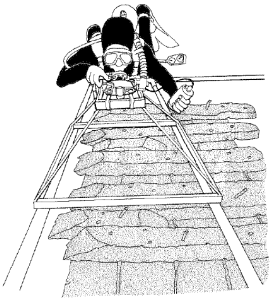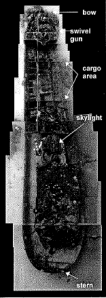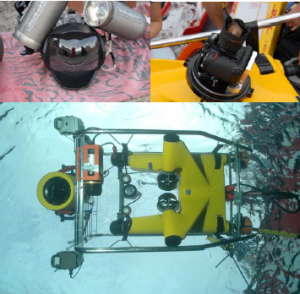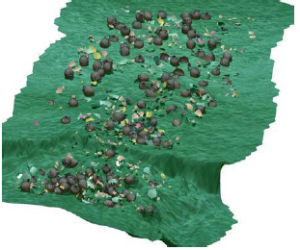Photography in an underwater archaeological setting plays an integral role. It is much more than just simply taking appealing pictures of artefacts and submerged landscapes. Not only is camerawork usage highly practical as a means of recording information on a site, it can be applied in many different aspects in the field. These range from general practices such as illustrated photos of artefacts or work being conducted for public awareness to more technical methods that provide information with which accurate site plans and the analysis and interpretation of finds underwater may be generated. The application of photographic methods, such as creating a photomosaic and photogrammetric techniques, will be discussed below.
Photographic mosaics:
This technique has been used as an ideal tool in site survey methodology since the 1970’s (Finney and Stephen 2005). The main reason mosaics are produced is lack of visibility and clarity under water and/or the size of the site does not enable generation of an overall site photograph (Bowens 2009). As an alternative to such complications, a sequence of photos are taken at a determined range and are then combined or “stitched” together to create a holistic view of the site. The methods of photo production vary and are dependent on the type of two dimensional control used underwater. A control system is required in order to produce a properly scaled mosaic and consists of three elements: 1) a grid line consisting of a series of lines at fixed intervals set up across the site; 2) a grid frame control that uses square graduated frames; and 3) a network-controlled system made up of coordinates along the site (Green 2004). All cameras, whether underwater, digital or video, are attached to specialized equipment such as a photo tower to help prevent tilt. The resulting sequence of photos are produced with an overlap of at least fifty percent to ensure complete coverage of the site. An example of the grid frame control system is presented in Figure 1.

Figure 1. Illustration of photographer using a grid frame control (Bowens 2009: Figure 10.7)
Once all photos are compiled, they go through a process of rectification where each is augmented to the same scale and joined with the others to make one large picture. In the past this would have been an extremely tedious procedure, but recent technological advances in computer software have enabled the creation of mosaics with programs such as Photoshop (Figure 2). Even though a photomosaic is not a complete site plan, it is still an important tool with which to quickly reference a site. It can also serve as a visual inventory that provides a baseline for future survey work (Finney and Stephen 2005).

Figure 2. Photomosaic created using Photoshop. (Finney and Stephen 2005: Figure 2)
Photogrammetric techniques:
The practice of photogrammetry has been in use almost as long as photography itself (Kucukkaya 2003). When these techniques are applied in an underwater environment they can be extremely beneficial for maritime archaeologists. Application of photogrammetric techniques can be used at any depth; however, they are especially useful when utilized for deep-water sites, where the amount of time available to conduct conventional survey methods and diver safety both can become factors. These methods essentially produce accurate geometric measurements, where data from multi-viewpoint photographs are manipulated to obtain three-dimensional information (Green 2004). This information is produced through a process called phototriangulation. This method of triangulation is obtained through the use of a calibrated camera that is connected to a computer-modelling program such as Rhino, PhotoModeler, MicroStation, or VirtualMapper. Once the camera is calibrated, measurements are obtained via ray paths that originate from the focal point of the camera, and pass through the photographic image to various points on the site (Green, et al. 2002). A control system must be employed when using these photographic methods to maintain an appropriate scale for the data. There are several ways the images can be acquired. They can be taken in the same way as a photomosaic where, with a designed control system established, a diver takes a sequence of pictures of the site. However, when employing these methods in deep-water environments, the cameras are sometimes deployed from a remotely-operated vehicle (ROV) (Figure 3). Whether an ROV or underwater photographer compiles photographic data, an overlap of at least sixty percent must be maintained for proper coverage of the site.

Figure 3. Photograph of ROV used in photogrammetry underwater (Drap, et al. 2007: Figure 2).
After the photogrammetric survey is completed, the data must be referenced with an actual model of the material culture found at the site. Once cross-referenced in this manner, a highly accurate three-dimensional plan can be produced of the entire site (Figure 4).

Figure 4. Three dimensional site plan of a large artefact assemblage made from photogrammetry (Drap, et al. 2003: Figure 6).
It is apparent that underwater site photography methods have improved with advances in modern technology. It was not too long ago that photographic equipment was too cumbersome and expensive to be applied on a large scale; now they are easily accessible and produce better, more efficient images with a variety of user-friendly software packages. With the prospect that more insitu survey projects will become the norm in underwater archaeology, the use of methodologies outlined above can serve an exciting future role. Currently photographic methods not only provide accurate site detail, they also can be used as a valuable educational tool. This is particularly true as regards the general public, who may not even be aware of the abundance of human history that lies underwater, and will most likely be destined to remain there.
References:
Bowens, Amanda 2009 Underwater Archaeology: The NAS Guide to Principles and Practice. 2nd ed. Blackwell Publishing, West Sussex.
Drap, P, J Seinturier, D Scaradozzi, and P Gambogi… 2007 Photogrammetry for virtual exploration of underwater archeological sites. XXI International CIPA Symposium, 01-06 October, Athens, Greece
Drap, P, J Seinturier, and L Long 2003 A photogrammetric process driven by an Expert System: A new approach for underwater archaeological surveying applied to the’Grand Ribaud F’Etruscan wreck. Computer Vision and Pattern Recognition Workshop, 1: 1-6
Finney, S. and Stephen, J. 2005 Photomosaics in Shallow Water
Environments: Challenges and Results, Marcet i Barbe, R., Brebbia, C.A.,
Olivella, J., Maritime Heritage and Modern Ports, 195–206.
Green, J., Matthews, S., & Turanli, T. 2002, Underwater archaeological surveying using PhotoModeler, VirtualMapper: different applications for different problems. International Journal of Nautical Archaeology, 31(2), 283-292.
Green, Jeremy 2004 Maritime Archaeology—A Technical Handbook, Academic Press, San Diego.
Kucukkaya, Ayse Gulcin 2004 Photogrammetry and remote sensing in archeology. Journal of Quantitative Spectroscopy and Radiative Transfer 88: 83-88

